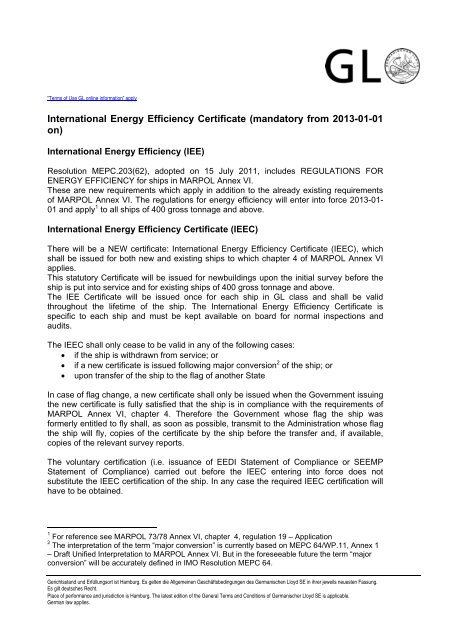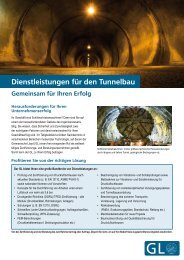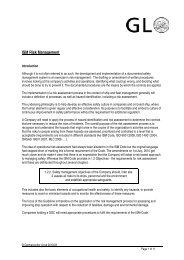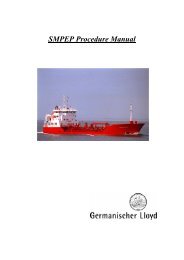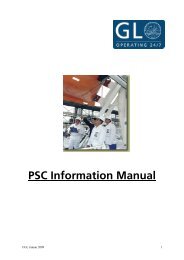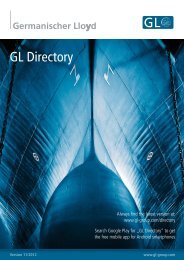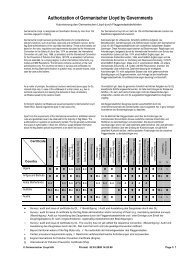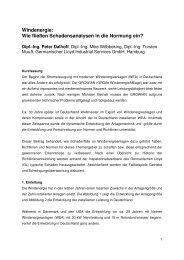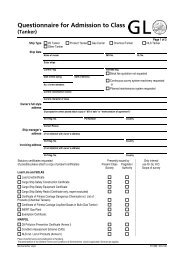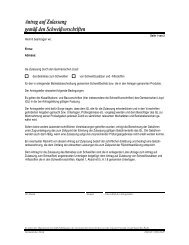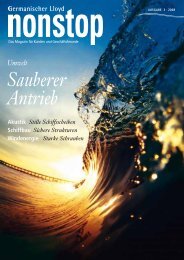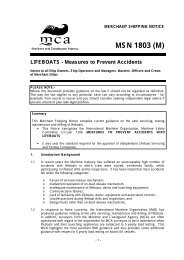International Energy Efficiency Certificate (mandatory ... - GL Group
International Energy Efficiency Certificate (mandatory ... - GL Group
International Energy Efficiency Certificate (mandatory ... - GL Group
Create successful ePaper yourself
Turn your PDF publications into a flip-book with our unique Google optimized e-Paper software.
”Terms of Use <strong>GL</strong> online information” apply<br />
<strong>International</strong> <strong>Energy</strong> <strong>Efficiency</strong> <strong>Certificate</strong> (<strong>mandatory</strong> from 2013-01-01<br />
on)<br />
<strong>International</strong> <strong>Energy</strong> <strong>Efficiency</strong> (IEE)<br />
Resolution MEPC.203(62), adopted on 15 July 2011, includes REGULATIONS FOR<br />
ENERGY EFFICIENCY for ships in MARPOL Annex VI.<br />
These are new requirements which apply in addition to the already existing requirements<br />
of MARPOL Annex VI. The regulations for energy efficiency will enter into force 2013-01-<br />
01 and apply 1 to all ships of 400 gross tonnage and above.<br />
<strong>International</strong> <strong>Energy</strong> <strong>Efficiency</strong> <strong>Certificate</strong> (IEEC)<br />
There will be a NEW certificate: <strong>International</strong> <strong>Energy</strong> <strong>Efficiency</strong> <strong>Certificate</strong> (IEEC), which<br />
shall be issued for both new and existing ships to which chapter 4 of MARPOL Annex VI<br />
applies.<br />
This statutory <strong>Certificate</strong> will be issued for newbuildings upon the initial survey before the<br />
ship is put into service and for existing ships of 400 gross tonnage and above.<br />
The IEE <strong>Certificate</strong> will be issued once for each ship in <strong>GL</strong> class and shall be valid<br />
throughout the lifetime of the ship. The <strong>International</strong> <strong>Energy</strong> <strong>Efficiency</strong> <strong>Certificate</strong> is<br />
specific to each ship and must be kept available on board for normal inspections and<br />
audits.<br />
The IEEC shall only cease to be valid in any of the following cases:<br />
• if the ship is withdrawn from service; or<br />
• if a new certificate is issued following major conversion 2 of the ship; or<br />
• upon transfer of the ship to the flag of another State<br />
In case of flag change, a new certificate shall only be issued when the Government issuing<br />
the new certificate is fully satisfied that the ship is in compliance with the requirements of<br />
MARPOL Annex VI, chapter 4. Therefore the Government whose flag the ship was<br />
formerly entitled to fly shall, as soon as possible, transmit to the Administration whose flag<br />
the ship will fly, copies of the certificate by the ship before the transfer and, if available,<br />
copies of the relevant survey reports.<br />
The voluntary certification (i.e. issuance of EEDI Statement of Compliance or SEEMP<br />
Statement of Compliance) carried out before the IEEC entering into force does not<br />
substitute the IEEC certification of the ship. In any case the required IEEC certification will<br />
have to be obtained.<br />
1 For reference see MARPOL 73/78 Annex VI, chapter 4, regulation 19 – Application<br />
2 The interpretation of the term “major conversion” is currently based on MEPC 64/WP.11, Annex 1<br />
– Draft Unified Interpretation to MARPOL Annex VI. But in the foreseeable future the term “major<br />
conversion” will be accurately defined in IMO Resolution MEPC 64.<br />
Gerichtsstand und Erfüllungsort ist Hamburg. Es gelten die Allgemeinen Geschäftsbedingungen des Germanischen Lloyd SE in ihrer jeweils neuesten Fassung.<br />
Es gilt deutsches Recht.<br />
Place of performance and jurisdiction is Hamburg. The latest edition of the General Terms and Conditions of Germanischer Lloyd SE is applicable.<br />
German law applies.
IEEC scope for ships in service<br />
Germanischer Lloyd<br />
Seite 2<br />
Each existing ship shall keep on board a ship-specific Ship <strong>Energy</strong> <strong>Efficiency</strong> Management<br />
Plan.<br />
Platforms (including FPSOs and FSUs) and drilling rigs are NOT required to have a<br />
SEEMP.<br />
The verification of the requirement to have a SEEMP on board shall take place at the first<br />
intermediate or renewal survey whichever is the first, on or after 1 January 2013. The<br />
SEEMP is required on board starting from the time of the survey, not earlier.<br />
For ships in service, the IEEC initial survey will be in connection with an<br />
intermediate/renewal survey of the IAPP certificate, i.e. these IAPP survey windows will<br />
also become the IEEC initial survey date for existing ships. An approval of the SEEMP by<br />
<strong>GL</strong> in advance to the intermediate or renewal survey is not required.<br />
The Ship <strong>Energy</strong> <strong>Efficiency</strong> Management Plan is regulated in MARPOL 73/78, Annex VI,<br />
chapter 4, regulation 22. The SEEMP provides an approach on an operational basis by<br />
monitoring ship and fleet efficiency performance.<br />
The SEEMP lists the measures which are used for improving the energy efficiency of a<br />
ship. Upon the survey, the surveyor will check if the SEEMP is available on board. The<br />
SEEMP should be established in a working language used on board. <strong>GL</strong> expects ships to<br />
have the SEEMP in the same language as the majority of the other documents on board. A<br />
sample form of the SEEMP can be found in “IMO Resolution MEPC.213(63) – 2012<br />
Guidelines for the development of a Ship <strong>Energy</strong> <strong>Efficiency</strong> Management Plan”. Resolution<br />
MEPC.213(63) will be provided on the <strong>GL</strong> homepage.<br />
The ship owner is obliged to develop a SEEMP taking into account the guidelines adopted<br />
by the <strong>International</strong> Maritime Organisation. The Ship <strong>Energy</strong> <strong>Efficiency</strong> Management Plan<br />
may form a part of the ship’s safety management system 3 . The ship owner assumes full<br />
responsibility that each ship of their fleet keeps a ship-specific <strong>Energy</strong> <strong>Efficiency</strong><br />
Management Plan.<br />
In case of the existence of the SEEMP on board an existing ship, the <strong>International</strong> <strong>Energy</strong><br />
<strong>Efficiency</strong> <strong>Certificate</strong> (IEEC) is issued. In case of a missing SEEMP, the recognised<br />
organisation should seek the advice of the Administration concerning the issuance of an<br />
IEEC. However if the SEEMP is missing, it has NO effect on the <strong>International</strong> Air Pollution<br />
Prevention (IAPP) certificate.<br />
If you request assistance in developing a SEEMP, please contact us. Our SEEMP experts<br />
will get in touch with you and we may offer to assist in compiling a well grounded SEEMP.<br />
IEEC scope for ship new buildings<br />
The IEE <strong>Certificate</strong> for ship new buildings consists basically of 2 items which will be<br />
checked upon the MARPOL Annex VI survey and will be confirmed in the certificate.<br />
1) Availability of Ship <strong>Energy</strong> <strong>Efficiency</strong> Management Plan (SEEMP)<br />
3 The term “safety management system” is well defined in the ISM-Code, Part A, paragraph 1.1.4.
Germanischer Lloyd<br />
Seite 3<br />
The SEEMP is <strong>mandatory</strong> for each new ship. For newbuildings, the IEEC initial survey<br />
will be performed during the newbuilding phase of the ship.<br />
For SEEMP related requirements being necessary for the issuance of the IEEC please<br />
refer to “IEEC scope for ships in service”.<br />
2) Availability of <strong>Energy</strong> <strong>Efficiency</strong> Design Index (EEDI)<br />
The EEDI is required only for ship new buildings. The term “new ship” is well defined as a<br />
ship for which the building contract is placed on or after 1 January 2013; or in the absence<br />
of a building contract, the keel of which is layed or which is at a similar stage of<br />
construction on or after 1 July 2013; or the delivery of which is on or after 1 July 2015.<br />
The EEDI is required only for the following ship types of 400 gross tonnage and above:<br />
- Bulk Carrier<br />
- Gas Carrier<br />
- Tanker<br />
- Container Ship<br />
- Refrigerated Cargo Ship<br />
- General Cargo Ship<br />
- Combination Carrier<br />
The attained EEDI value should be lower than the pre-defined reference line for the<br />
chosen ship category. In order to determine the reference line, an exponential regression<br />
analysis has been carried out by plotting the calculated estimated index values against the<br />
deadweight. This method generates a curve out of all available data sets representative for<br />
each individual ship category. The following figure displays the EEDI required reference<br />
lines, applicable for container ships, valid for the respective reduction phase:<br />
g CO2 / (t*nm)<br />
50<br />
45<br />
40<br />
35<br />
30<br />
25<br />
20<br />
15<br />
10<br />
5<br />
0<br />
EEDI requirement for container vessels<br />
Reference line - 2013 Phase 1 - 2015<br />
Phase 2 - 2020 Phase 3 - 2025<br />
0 50.000 100.000<br />
DWT<br />
150.000 200.000<br />
Figure 1: EEDI reference line for container ships<br />
The EEDI Technical File contains the technical documentation which proves that the<br />
energy efficiency of the ship (= attained EEDI) is below the allowed limit (= required EEDI).<br />
The EEDI Technical File has to be approved by the recognized organization or a<br />
classification society on their behalf.
Germanischer Lloyd<br />
Seite 4<br />
In the future the required EEDI shall be reduced stepwise. The future EEDI reduction<br />
factors, cut off limits and implementation phases against the ship specific reference lines<br />
are intended to be as follows:<br />
Table 1: EEDI – reduction factor scheme<br />
*Reduction factor to be linearly interpolated between the two values dependent upon vessel size.<br />
The lower value of the reduction factor is to be applied to the smaller ship size.<br />
The attained as well as the required EEDI do not yet apply to ships which have dieselelectric<br />
propulsion, turbine propulsion or hybrid propulsion systems. However the<br />
introduction of non-conventional propulsion systems and further ship types under the EEDI<br />
regime are considered by the IMO.<br />
IEEC procedure under the EEDI Regime for newbuildings of 400 GT and above<br />
The EEDI related procedures on survey and certification are regulated in “IMO Resolution<br />
MEPC.214 (63) – Guidelines on survey and certification of the <strong>Energy</strong> <strong>Efficiency</strong> Design<br />
Index” and “MEPC 64/INF.22 – First version of industry guidelines on calculation and<br />
verification of the <strong>Energy</strong> <strong>Efficiency</strong> Design Index”.<br />
The verification stages for IEE Certification can be divided into the application for IEE<br />
certification, the EEDI preliminary verification, the EEDI final verification and the issuance<br />
of the IEEC. The detailed process steps can be found in the flowchart “<strong>International</strong><br />
<strong>Energy</strong> <strong>Efficiency</strong> Certification – Process Steps”.<br />
Documents to be submitted at design stage<br />
- EEDI Technical File<br />
- NOx Technical File<br />
- Electric Power Table (applicable if PAE is significantly different from the values<br />
computed using the formula in 2.5.6.1 or 2.5.6.2 of the IMO Calculation Guidelines<br />
MEPC.212(63))<br />
- Ship lines and model particulars
Germanischer Lloyd<br />
Seite 5<br />
- Verification file of power limitation technical arrangement<br />
(in case of limited propulsion power)<br />
- Power curves<br />
- Quality Management System certification acc. ISO 9001, in case the QSM is not<br />
ISO 9001 certified: a description of the tank test institute (to be submitted prior to<br />
tank tests)<br />
- Gas fuel oil general arrangement plan (only if gas fuel is used as primary fuel)<br />
- Tank Test Plan (to be submitted prior to tank tests)<br />
- Tank Test Report of Tank Test Facility containing requirements as agreed and<br />
contracted<br />
- Ship reference speed vref<br />
Documents to be submitted at the final verification stage<br />
- Programme of sea trial (to be submitted prior to speed trial at sea trial)<br />
- Sea Trial Report (to be submitted after sea trial performance)<br />
- Final stability file (to be submitted after sea trial performance)<br />
- Final power curves and power tables (to be submitted after sea trial performance)<br />
- Revised EEDI Technical File (to be submitted after sea trial performance)<br />
- Ship lines (to be submitted after sea trial performance)<br />
The documents which have to be submitted are also listed in the application forms<br />
“F318FE– Application Form for Preliminary Verification of the EEDI at Design Stage” and<br />
“F318GE– Application Form for Final Verification of the EEDI at Sea Trial”. The application<br />
forms are available on the <strong>GL</strong> homepage under the item <strong>GL</strong>-Forms.<br />
1) Application for IEE certification<br />
a) Prior to the survey and certification, the shipowner is asked to submit the application<br />
form F318FE and the requested documents as listed above, see documents to be<br />
submitted at design stage to <strong>GL</strong>-Head Office.<br />
After the procedure for the tank test is agreed between the submitter and <strong>GL</strong>, and after<br />
the tank test has been performed, the submitter is obliged to submit the full tank test<br />
reports containing the contracted requirements, to <strong>GL</strong>-Head Office.<br />
The application Form has to be submitted to <strong>GL</strong>-Head Office in the time period from<br />
contract date to at least 12 weeks prior to sea trial.<br />
2) EEDI preliminary verification<br />
b) The <strong>GL</strong> verifier at <strong>GL</strong>-Head Office verifies and checks the EEDI Technical File as well<br />
as the enclosed documents as listed in application form F318FE. If applicable the<br />
verifier reviews the Electric Power Table, checking if all relevant loads are listed in the<br />
EPT, if reasonable service factors are used and checking the correctness of the PAE<br />
calculation based on the data given in the EPT. Furthermore the verifier reviews and<br />
witnesses the model tank test reports and calculates the attained EEDI as well as the<br />
required EEDI value based on the EEDI Technical File and the model tank tests.<br />
c) The verifier at <strong>GL</strong>-Head Office issues the Attestation S069 – Report on Preliminary<br />
Verification of EEDI. This document confirms that the preliminary EEDI verification has<br />
been conducted. However, it should be noted that the verifier has only the obligation to<br />
check the existence and correctness of the calculations in accordance to the<br />
guidelines, but not the predicted value by the submitter as such.
3) EEDI final verification<br />
Germanischer Lloyd<br />
Seite 6<br />
d) At least 6 weeks prior to the sea trial the shipowner is obliged to submit to <strong>GL</strong>-Head<br />
Office the application form F318GE for final verification of the EEDI at sea trial and<br />
requested documents as listed above, see documents to be submitted at the final<br />
verification stage.<br />
Prior to the sea trial the following documents should be submitted: A description of the<br />
test procedure/ sea trial programme, the final stability file containing the displacement<br />
table or a copy of the survey report of deadweight, the lightweight certificate and the trim<br />
& stability booklet.<br />
e) The Chief surveyor allocates a <strong>GL</strong> representative to attend and survey the speed trial<br />
which is conducted under sea trial conditions.<br />
f) A sea trial is conducted under the conditions as specified in IMO Resolution<br />
MEPC.212(63), paragraph 2.2. The <strong>GL</strong> representative surveys if the speed trial under<br />
sea trial conditions has been carried out in accordance with the guidelines adopted by<br />
the <strong>International</strong> Maritime Organisation.<br />
The <strong>GL</strong> representative completes Form 318CE- Speed Trial EEDI, F318EE-EPT (if<br />
applicable) and checks if a ship-specific SEEMP is available on board the ship.<br />
Subsequently he completes the checklist F318DE - MARPOL 73/78 Annex VI <strong>Energy</strong><br />
<strong>Efficiency</strong> Initial Survey.<br />
g) The shipyard modifies and submits the revised EEDI Technical File and the sea trial<br />
reports for final validation. The EEDI Technical File is revised by taking into account the<br />
results of the speed trial (i.e. adjusted power curve, finally determined EEDI capacity).<br />
The verifier at <strong>GL</strong>- Head Office checks the revised EEDI Technical File to make sure the<br />
content matches the performance results recorded from the shipyard as well as from the<br />
<strong>GL</strong> representative who attends the speed trial.<br />
h) The <strong>GL</strong> verifier at <strong>GL</strong>-Head Office checks the EPT-Form (if applicable). Checking if the<br />
selected units/loads specified in the EPT were observed during the sea trial and<br />
calculating the EEDI reference speed based on the results of the speed trial and the<br />
EEDI conditions. The attained ship-specific EEDI and the required EEDI values are<br />
recalculated by the <strong>GL</strong> verifier at <strong>GL</strong>-Head Office based on the modifications in<br />
accordance to the EEDI conditions.<br />
i) The <strong>GL</strong> verifier issues the Attestation S070 – Report on Final Verification of EEDI.<br />
4) Issuance of IEEC<br />
j) When the ship is delivered, the <strong>International</strong> <strong>Energy</strong> <strong>Efficiency</strong> <strong>Certificate</strong> is issued by<br />
<strong>GL</strong>- Head Office.<br />
If a client orders the IEEC <strong>Certificate</strong> before the entry into force, an ENERGY<br />
EFFICIENCY STATEMENT OF COMPLIANCE will be issued instead because no IEE<br />
<strong>Certificate</strong> can be issued when the regulation is not in force. Once the regulation is in<br />
force, the STATEMENT OF COMPLIANCE will be reissued as <strong>International</strong> <strong>Energy</strong><br />
<strong>Efficiency</strong> <strong>Certificate</strong> (IEEC).<br />
In case the flag state has not ratified MARPOL Annex VI, the IEEC SoC will be reissued<br />
as IEEC Document of Compliance.
Germanischer Lloyd<br />
Seite 7<br />
All necessary document forms to be submitted to <strong>GL</strong> Head Office will be available online<br />
for download.<br />
The mentioned documents are to be submitted in a complete and timely manner. Only this<br />
will trigger the process of <strong>Energy</strong> <strong>Efficiency</strong> certification and provide <strong>GL</strong> with all information<br />
about the ship.<br />
For further questions, please contact energy.efficiency@gl-group.com.<br />
Or visit “Rules for Classification and Construction, VI Additional Rules and Guidelines,<br />
chapter 13 <strong>Energy</strong> <strong>Efficiency</strong>” on the <strong>GL</strong> homepage.


